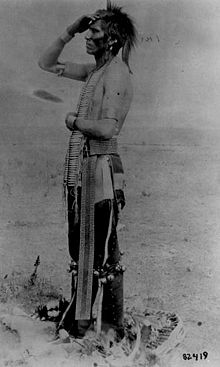Assiniboine
+Add origin to My Preferences The Assiniboine or Assiniboin people (/əˈsɪnɨbɔɪn/ when singular, /əˈsɪnɨbɔɪnz/ when plural; Ojibwe: Asinaan, "stone Sioux"; also in plural Assiniboine or Assiniboin), also known as the Hohe and known by the endonym Nakota (or Nakoda or Nakona), are a Sioux First Nations/Native American people originally from the Northern Great Plains of North America. Today, they are centered in present-day Saskatchewan, but they have also populated parts of Alberta, southwestern Manitoba, northern Montana and western North Dakota. They were well known throughout much of the late 18th and early 19th century. Images of Assiniboine people were painted by such 19th-century artists as Karl Bodmer and George Catlin.
The Assiniboine or Assiniboin people (/əˈsɪnɨbɔɪn/ when singular, /əˈsɪnɨbɔɪnz/ when plural; Ojibwe: Asinaan, "stone Sioux"; also in plural Assiniboine or Assiniboin), also known as the Hohe and known by the endonym Nakota (or Nakoda or Nakona), are a Sioux First Nations/Native American people originally from the Northern Great Plains of North America. Today, they are centered in present-day Saskatchewan, but they have also populated parts of Alberta, southwestern Manitoba, northern Montana and western North Dakota. They were well known throughout much of the late 18th and early 19th century. Images of Assiniboine people were painted by such 19th-century artists as Karl Bodmer and George Catlin.
The Assiniboine were originally part of the Great Sioux Nation which was made up of Eastern Dakota or Santee, Western Dakota or Yanktonai, and the Lakota or Teton Sioux. The Sioux were pushed gradually westward onto the plains from the woodlands of Minnesota by the Ojibwe people who acquired guns earlier from their French allies. Specifically the Assiniboine were part of the Yanktonai Sioux but split off around 1640 and headed north were they developed into a powerful and distinct people. Before horses were introduced to the Assiniboine they used domestic dogs as a pack animal to carry their belongings and pull their travois. The Assiniboine acquired horses by raiding and trading with neighboring plains nations such as the Crow and Sioux living further south who obtained horses earlier. The Assiniboine eventually developed into a large and powerful people with a horse and warrior culture centered around the vast numbers of bison that lived within and outside their territory. Assiniboine territory at the height of their power stretched from the North Saskatchewan River in the north to the Missouri River in the south and included portions of modern day Saskatchewan, Alberta, Manitoba, North Dakota, and Montana. (Read more about Assinbine people.)
Source: Wikipedia
View Items from other Tribes Here:
- Acoma Pueblo, Haak’u
- Akimel O'odham, Pima
- Apache, American Indians
- Cochiti Pueblo, KO-TYIT
- Diné of the Navajo Nation
- Hopi Pueblo, Hopituh Shi-nu-mu
- Isleta Pueblo, Tue-I
- Jemez Pueblo, Walatowa
- KEWA, Santo Domingo Pueblo
- Kiowa Nation
- Laguna Pueblo, Ka'waika
- Maricopa, Peeposh Tribe
- Mojave Tribe
- Nambe Pueblo, Nanbé Ówingeh
- Ohkay Owingeh, San Juan Pueblo
- Picuris Pueblo, Pe’ewi
- Pojoaque Pueblo, PO-SUWAE-GEH
- Potawatomi Nation
- San Felipe Pueblo, Katishtya
- San Ildefonso Pueblo, Po-woh-ge-oweenge
- Sandia Pueblo, NA-FIAT
- Santa Ana Pueblo, Tamaya
- Santa Clara Pueblo, Kha'p'oo Owinge
- Taos Pueblo, Tuah-Tah
- Tesuque Pueblo, TET-SUGEH
- Tohono O´odham, Papago
- Zia Pueblo, Tsi-ya
- Zuni Pueblo, SHE-WE-NA

